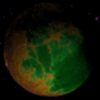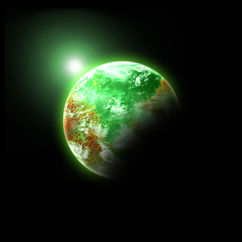Acid World: Difference between revisions
Tristavius (talk | contribs) Added some examples - still trying to work out how to convert the planet data density into the in-game Mass in 'es' (I assume Earth Standard?). Moved notes to separate section. Added additional descriptive text. Completed extra fields for info box. |
Tristavius (talk | contribs) |
||
| Line 19: | Line 19: | ||
Acid worlds are represented in the solar system view as green planets and and tend to be resource poor, offering only large quantities of Common Minerals in the form of Acids and low chances of bearing life. | Acid worlds are represented in the solar system view as green planets and and tend to be resource poor, offering only large quantities of Common Minerals in the form of Acids and low chances of bearing life. | ||
Acid worlds have low to moderate tectonics (2 to 5) and weather conditions (1 to 4) with average gravity (0.24 - 0.38). Fuel costs for landing vary between 0.5 and 0.8 with an average of 0.62. Overall Acid worlds tend to be around | Acid worlds have low to moderate tectonics (2 to 5) and weather conditions (1 to 4) with average gravity (0.24 - 0.38). Fuel costs for landing vary between 0.5 and 0.8 with an average of 0.62. Overall Acid worlds tend to be around one third of the size of Earth and three quarters lack an atmosphere. | ||
== Resources == | == Resources == | ||
Revision as of 06:09, 30 March 2016
Description
Acid worlds are represented in the solar system view as green planets and and tend to be resource poor, offering only large quantities of Common Minerals in the form of Acids and low chances of bearing life.
Acid worlds have low to moderate tectonics (2 to 5) and weather conditions (1 to 4) with average gravity (0.24 - 0.38). Fuel costs for landing vary between 0.5 and 0.8 with an average of 0.62. Overall Acid worlds tend to be around one third of the size of Earth and three quarters lack an atmosphere.
Resources
The following resources are found on Acid Worlds:
| Mineral | Category | Deposit Size | Avg Dwarf1 | Avg Giant2 | Avg Super3 |
|---|---|---|---|---|---|
| Formic Acid | Common | Heavy | 31 | 41 | 51 |
| Hydrochloric Acid | Common | Heavy | 31 | 41 | 51 |
| Hydrocyanic Acid | Common | Heavy | 31 | 41 | 51 |
| Nitric Acid | Common | Heavy | 31 | 41 | 51 |
| Phosphoric Acid | Common | Heavy | 31 | 41 | 51 |
| Sulfuric Acid | Common | Heacy | 31 | 41 | 51 |
Life forms are rare and are found on only 10.8% of Acid Worlds, accounting for an average of 52 units per life bearing world. (Minimum 2, Maximum 186).
Known Worlds
The following are known examples of Acid Worlds:
| System | Planet | Orbit | Atmosphere | Temperature | Weather | Tectonics | Mass | Radius | Gravity | Day | Tilt | Life |
|---|---|---|---|---|---|---|---|---|---|---|---|---|
| Octanis (Alpha) | 1 | 5.27 AU | 2.10 atm | 2835 °C | Class 3 | Class 4 | 0.03 es | 0.32 es | 0.31g | 0.91 days | 1° | No |
| Antliae (Alpha) | IV-d | 4.44 AU | 0 atm | -76°C | Class 1 | Class 2 | 0.98 es | 0.31 es | 0.3g | 1.24166666666667 days | -12° | 0 units |
| Antliae (Delta) | I | 1.56 AU | 7.5 atm | 84°C | Class 3 | Class 2 | 1.03 es | 0.35 es | 0.36g | 1.22916666666667 days | -18° | 33 units |
| Aquarii (Beta) | V-a | 9 AU | 0 atm | -162°C | Class 1 | Class 4 | 1.02 es | 0.26 es | 0.26g | 1.02083333333333 days | 5° | 0 units |
| Arae (Delta) | IV | 7.6 AU | 0 atm | -183°C | Class 1 | Class 3 | 1 es | 0.37 es | 0.37g | 0.733333333333333 days | -11° | 0 units |
| Betelgeuse (Prime) | II | 2.81 AU | 0.22 atm | -2°C | Class 2 | Class 2 | 1.01 es | 0.32 es | 0.32g | 1.05 days | -19° | 0 units |
| Camelopardalis (Beta) | VI | 14.14 AU | 0 atm | -185°C | Class 1 | Class 5 | 1.04 es | 0.32 es | 0.33g | 0.745833333333333 days | 14° | 0 units |
| Camelopardalis (Delta) | III-b | 6.82 AU | 0 atm | -146°C | Class 1 | Class 2 | 0.98 es | 0.33 es | 0.32g | 229.270833333333 days | 25° | 0 units |
| Camelopardalis (Zeta) | I-c | 3.18 AU | 0 atm | -180°C | Class 1 | Class 3 | 1 es | 0.35 es | 0.35g | 1.06666666666667 days | 22° | 0 units |
| Cancri (Alpha) | II | 3.54 AU | 0 atm | -97°C | Class 1 | Class 4 | 0.96 es | 0.34 es | 0.32g | 0.9875 days | 30° | 0 units |
| Cancri (Alpha) | III-a | 5.91 AU | 0 atm | -137°C | Class 1 | Class 5 | 1.02 es | 0.3 es | 0.30g | 122.25 days | 13° | 0 units |
| Carinae (Beta) | IX-a | 14.94 AU | 0 atm | -166°C | Class 1 | Class 3 | 1.01 es | 0.33 es | 0.33g | 132.391666666667 days | 8° | 0 units |
| Cassiopeiae (Gamma) | II-d | 2.52 AU | 0 atm | -116°C | Class 1 | Class 2 | 1.05 es | 0.32 es | 0.33g | 0.708333333333333 days | -11° | 0 units |
| Centauri (Beta) | I-b | 3.84 AU | 0 atm | -104°C | Class 1 | Class 2 | 1 es | 0.33 es | 0.33g | 0.629166666666667 days | -2° | 0 units |
| Cerenkov (Alpha) | VIII-b | 13.25 AU | 0 atm | -159°C | Class 1 | Class 2 | 1.01 es | 0.26 es | 0.26g | 0.870833333333333 days | 6° | 0 units |
| Cerenkov (Beta) | VI-a | 11.98 AU | 0 atm | -225°C | Class 1 | Class 4 | 0.98 es | 0.33 es | 0.32g | 1.17083333333333 days | 5° | 0 units |
Notes and references
- 1Avg Dwarf is the average number of units of the mineral one could expect to find on such a planet around a Dwarf star.
- 2Avg Giant is the average number of units of the mineral one could expect to find on such a planet around a Giant star..
- 3Avg Super is the average number of units of the mineral one could expect to find on such a planet around a Supergiant star...


